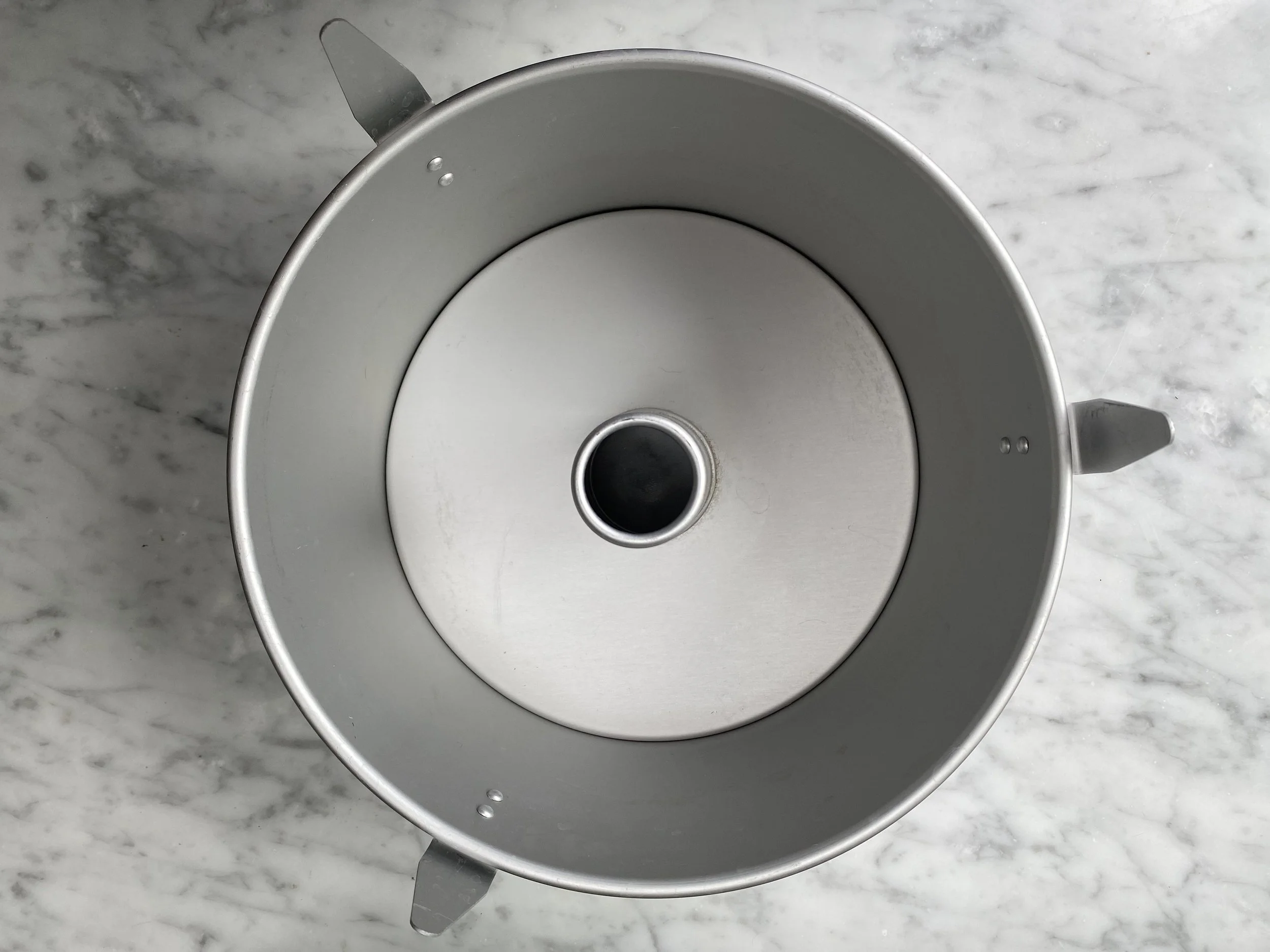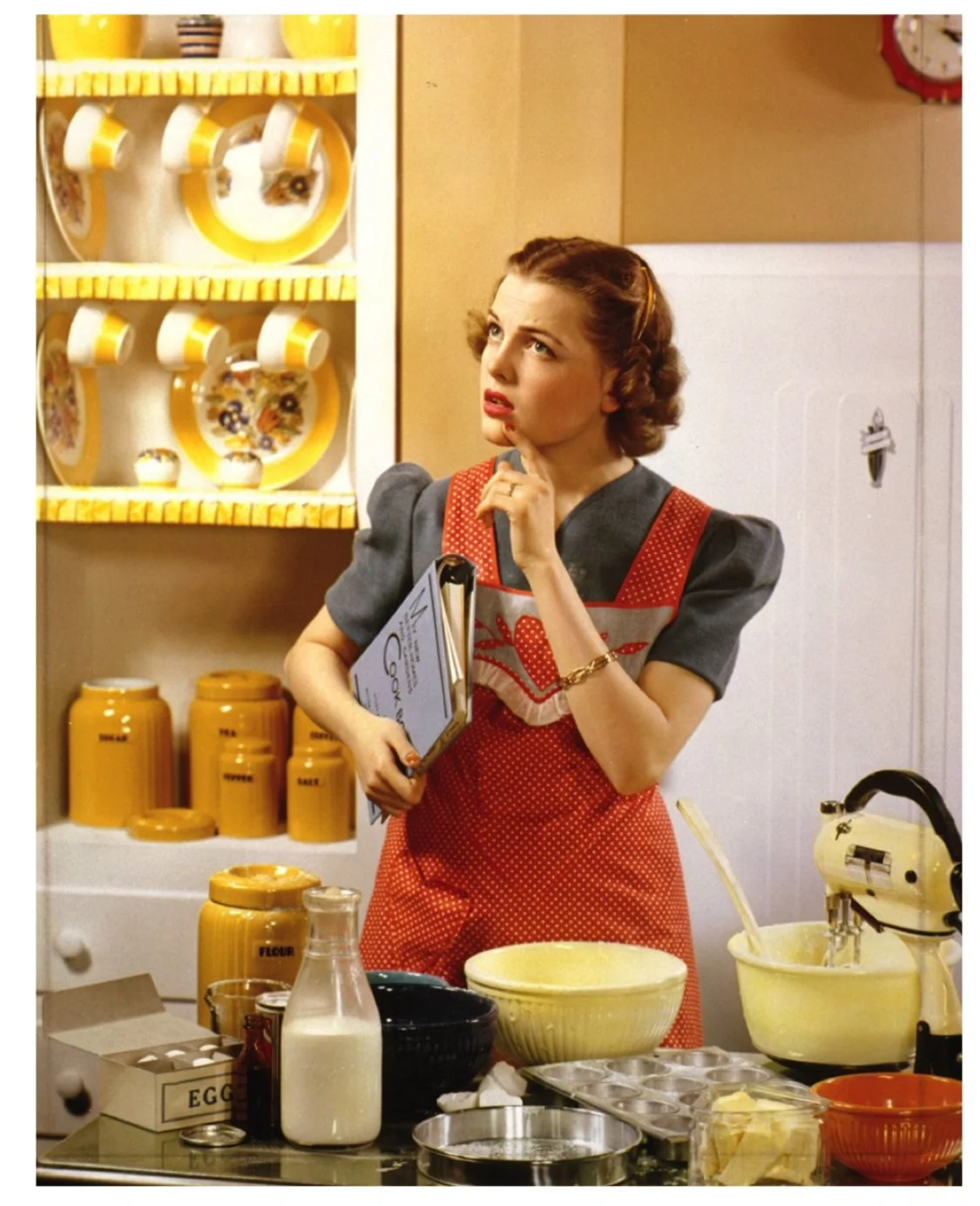‘Angel Food’ Cake
A Recipe
Sometime way back in the day of pre-pandemia, I spent a ‘look-see’ day in a Day True kitchen showroom, arriving alongside an untraceable package containing an Angel Food cake tin (or ‘tube pan’, in USian terminology). Most of those present couldn’t make sense of this strangely shaped mould – with its straight deep sides, legs pointing heavenward, and an elevated funnel-shaped hole through its middle – less still of who might have ordered it, for what purpose, or to where it could be returned. By this quirk of fate, the tin took up a long-term residency in this facsimile of a home kitchen, where it remained unwanted, unloved, and unused.
The cake it was designed for seemed to me then as out of time as the tin was out of place – a cake of a kind last seen trapped in the ‘aspic-adjacent’ pages of a mid-century cookbook written by a worthy home-economist, measuring out ingredients in fool-proof amounts for an audience of previous era ‘housewives’ as they set out to ‘entertain’.
On a recent return journey to Day True, I became reacquainted with this same tin, now ‘on display’ (an upgrade of sorts), and made a mental note to do it justice, by using it to bake the cake for which it is solely designed – after all, what can there be not to love about a cake named as the food of actual Angels?
In a bit of a hurry on an appropriately nominated baking day – a Sunday in the Parish of Wimbledon (Village) – I turned for instruction to a YouTube ‘short’ where a perky ‘Professional Baker’ took me through the necessary steps in the language of origin of the cake (ie North American). Measurements were in cups and teaspoons (appropriate for a showroom kitchen that currently lacks a weighing scale), and instructions were clearly explained: the ‘what’ and the ‘why’.
Carole Lombard: “Love Before Breakfast” 1936 – proposed to by C. Gable in a chiffon cake-joint
The result was a revelation – a light springy ‘chiffon*’ of a cake (*a technical term for the texture that perhaps originates alongside early associations with the 1930’s sirens of Hollywood’s Silver Screen, who were said to be partial to the charms of a chiffon). If meringue were a cake, this cake would be it – a cloud soft whisper of heaven-sent sweetness, it is utterly divine. The angels would weep to know we’ve left this tin languishing, adrift from its destiny – at least until now – and my telling of this recipe, in all its glory hallelujah, is duly devoted to their choir.
Fun Facts
Eleanor Roosevelt (first lady of the USA, 1933 – 1945), was always served an Angel Food Cake in celebration of her birthdays at the White House.
The origins of the cake are hard to pin down, but thought to derive from sometime in late 19th Century North America. It is documented as arriving in the UK around 1932, here known as Angel Cake
The first packet angel food cake mix appeared in the US around 1942. With a ‘just add water’ formula, packet mix “advertisements worked hard to convince home cooks this product was an acceptable substitute for home made.”
Angel Food Cake
Ingredients:
8 x egg whites
½ teaspoon cream of tartar
a pinch of salt
½ cup icing sugar (sieved)
½ teaspoon vanilla essence
1 cup plain white cake flour (softer than plain flour – although, full confession, I used plain flour and it worked fine – also, very much not to be confused with ‘self-raising’ flour, which is flour that contains a raising agent.
1 cup granulated sugar
Method:
With an electric whisk attachment – on a hand blender or in a stand mix – whisk the egg whites with the cream of tartar and salt until the egg whites are generously foaming and have turned from ‘yellow’ to ‘white’ (they don’t need to fully ‘develop’ (/ ‘foam’ to the max) at this stage).
Sieve the icing sugar into the whites – gradually – while continuing to whisk the whites (don’t add the sugar too fast, or the whites will collapse).
Continue whisking until the whites have reached a ‘medium’ peak (ie if you lift the whisk out of the bowl, the peak that is formed should be distinctly ‘firm’, but not fully ‘upright’ – it should ‘droop’ slightly at the tip.
Add the vanilla essence, then sieve and fold the flour and granulated sugar carefully into the whites. Use a hand-held whisk to fold, if you have one, or a metal spoon or baking spatula if you don’t – either way, fold ‘gently’ so as not to knock out the air you have carefully added to the egg whites.
Transfer to the tin, which should be clean, dry, and otherwise ‘unprepared’ (a special joy!) – this is a cake that you want to stick to the sides of the tin as it climbs upwards. And this is why you need a dedicated tin – this cake needs to cook evenly (hence the hole in the middle) and needs to be totally flat (hence allowing it to stick to all the surfaces). Even up the batter around the tin so that it finds a general level.
Place in a (pre-heated) oven at 160ºC – I used a VZug combi-steam oven and had it set to ‘hot-air, humid’ (ie the temperature is evenly distributed, but the moisture present in the cake is not extracted from the oven – it’s different from ‘fan’ or from ‘hot air with steam’ – but if you don’t have this setting, just a general 160ºC – with fan if you’ve got it – will do).
Bake for about 30–35 minutes (check after 30) – the cake is ready if it springs back when you push gently at its surface.
Turn out upside down on a (heat-proofed) work surface (you don’t need a cooling rack if your cake tin has legs). The cake needs to cool fully while hanging upside down (to stretch it and to stop it from sinking back on itself), and it needs air to circulate under it (hence those crazy pointed legs).
Once cool, you will have to release the edges using a flexible palette knife (or equivalent), around the outer edge, and something like a skewer around the inner ‘hole’. if the tin lacks a ‘loose bottom’ (another technical term) turn out the cake by giving it a sharp tap on a (sturdy!) counter. With a moveable base you can just push the cake out and onto a serving platter or plate before removing the base – use the palette knife or equivalent to help if you need it.
Serve in slices, with fresh berries and whipped cream.
Crème Anglaise
An Angel Cake is sometimes quoted as a solution for using up ‘surplus’ egg whites (from making, eg pasta noodles). Contrary-wise, if the cake itself is the priority, there are now a lot of surplus egg yolks.
They can be stored overnight in the fridge (keep them in a container where they are exposed to as little air as possible), and used for other purposes. With a quantity of eight, a Crème Anglaise (a custard and a traditional base for making ice-cream) is one solution.
The recipe below is a shortcut method for the custard made in a steam oven – the alternative/traditional method uses a saucepan, scalded milk, a gentle heat and some careful stirring – which all takes a bit more hands-on effort, if not more time, and carries a lot more jeopardy.
Crème Anglaise (steam oven method)
Ingredients:
8 egg yolks
160g caster sugar
1-2 tsp vanilla bean paste
600ml double cream
100ml milk
Method:
Blend together egg yolks + sugar, then add vanilla (be generous) and, gradually, the cream and milk. You don’t want to whisk too much air into the mix, just that all should be blended evenly.
Pour into clean glass jars (with heat-proof lids) and put in (pre-heated) oven, with lids on, at 83ºC on a steam setting – steam for 30-40 minutes.
The custard is cooked once it has thickened (NB: above 83ºC you risk scrambling the egg, below it you may not get the custard to thicken, so be precise with the temperature). It can be used as is as hot custard or, if to be used later or for ice-cream, cool down immediately over ice (it needs to chill quickly), then keep chilled at fridge temperature. Should you be lucky enough to have access to a blast chiller, use it – this is where it comes into its own.
A crème anglaise will hold in the fridge for two days (max) – or, if churned and frozen into ice cream (in an ice cream maker, or by stirring/manually churning it regularly while it freezes in a container in the freezer), it can be stored frozen for up to two weeks.
The ice-cream in the image is churned with toasted, candied, crushed almonds.







